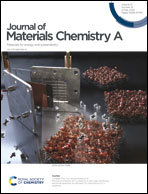Co,N-doped GQDs/SnO2 mesoporous microspheres exhibit synergistically enhanced gas sensing properties for H2S gas detection†
Abstract
Graphene quantum dots (GQDs) are emerging as one of the promising candidate materials that have the properties of both graphene and semiconductor quantum dots; moreover, they can be dispersed in common solvents and compounded with solid materials for developing high-performance gas sensors. In this work, we prepared cobalt (Co) and nitrogen (N) co-doped GQD-modified SnO2 composites (Co,N-GQDs/SnO2) by a solvothermal route, in which Co,N-GQDs were prepared by using citric acid, urea and CoCl2 as the source of the hydrothermal method. The optimal sensor response value toward 100 ppm H2S is about 37.3 at 260 °C, which is over 2 times higher than those of pure SnO2 mesoporous microspheres at 312 °C. In addition, this material has excellent selectivity, good reproducibility, fast response/recovery time (5/11 s to 100 ppm), and ppb-level H2S detection ability (1.18 to 50 ppb H2S). The superior sensing performance of Co,N-GQDs/SnO2 can be attributed to the increase of active sites on the surface of the materials and the electrical modulation of Co,N-GQDs. The facial fabrication and outstanding performance make our sensors highly attractive for H2S detection and expand the application fields of GQDs.



 Please wait while we load your content...
Please wait while we load your content...